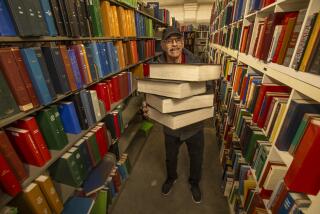Untangling the complicated legacy of nanny-photographer Vivian Maier
- Share via
It’s a story that is part “Storage Wars,” part “Antiques Roadshow.” A Chicago Realtor named John Maloof purchases an uncataloged trove of negatives at an auction in 2007. These orphaned negatives, it turns out, belonged to a nanny named Vivian Maier. And the black-and-white images they contain are exquisite: an attractive woman deep in thought, rumpled men with cigarettes dangling from their lips, a screaming child holding on to her mother’s overcoat.
The story of Vivian Maier was the story of a working class woman who was also an incredible street photographer. And it’s a story that has been told via newspaper articles, the many posthumous exhibitions of her work, and a celebrated 2013 documentary called “Finding Vivian Maier,” about Maloof’s discovery of her works and his effort to piece together the story of her life.
But over the last few months, the story of how Maier’s work came to light, and who has the right to sell and publish her photos, has gotten a little bit more complicated than that dreamy narrative would imply.
Some corners of the art world have expressed a bit of distaste with the posthumous production and sale of Maier’s prints, since she left no instructions for how her negatives and film should be handled, and no children, who might be empowered to manage her estate. Her photos can now sell for upward of $2,000 a piece.
Maloof actively sells Maier’s pictures through the Howard Greenberg Gallery in New York. He says this has brought him some criticism, as he told ArtInfo in an interview in March:
“Every time I get in front of people I’m getting, ‘How do you feel exploiting the work of a poor woman? You’re making all this money after she’s gone,’” he told the arts website. “I hate that because it’s not my goal to make this a business. There’s no way I can spend $80,000 to $100,000 scanning the work by waiting tables or whatever. I have to sell her prints.”
But Maloof says the money goes right back into funding more research. “Many people think I’m making millions of dollars when in reality the archive hasn’t made any money yet at all,” he told the website.
In addition, last month, The Independent reported on a couple of other collectors — Ron Slattery and Randy Prow — who had also bought pieces of Maier’s archive early on, but received no mention in Maloof’s documentary. Certainly, a revelation that makes the tidy story of discovery a little bit more complicated.
Add to that today’s report on the art blog Hyperallergic, which has an extensive Q&A with Jeffrey Goldstein, who acquired a portion of the Maier archive from those early collectors in 2010. He stated that Meier had left behind a distant heir.
“There’s a descendant,” Goldstein told Hyperallergic. “There is an heir to the lineage.”
He added: “I’m in a non-disclosure [agreement] with the French heir and John [Maloof]. So I’m really limited to what I can say, and part of that is the request of the heir.”
If there was an heir, this would be a big deal, because the conventional wisdom on Maier is that she left no one behind. I called the Howard Greenberg Gallery, which manages the sales of prints from Maloof’s archive. Frances Vignola, a representative from the gallery said that Maloof did indeed settle the issue of copyright with a distant relative of Maier’s in France, but because of the non-disclosure status of the agreement, she couldn’t reveal anything else.
“John did his due diligence and did his research,” she says. “He searched for years for the appropriate people then went to go see them and talked to them and he still talks to them.”
For the works that he owns, Maloof retains copyright to the work. As does Goldstein for the works in his archive. (Maloof owns the bulk of the images, which can be seen at VivianMaier.com, while Goldstein’s collection can be found at VivianMaierPrints.com.)
The talk of an heir, however, shouldn’t come entirely as a surprise. In his documentary, Maloof travels to the town of Saint Bonnet-en-Champsaur in France and meets with a distant cousin of Maier’s — a man identified only as “Sylvain.”
The gallery wouldn’t confirm or deny whether Sylvain is the sole heir. But certainly one can hazard a guess that it is him, or someone close to him.
The bigger question this raises is: who really has Vivian Maier’s best interests at heart? It’s hard to know. In an ideal world, her images would have ended up at an arts institution or a foundation, where the primary concern would have been academic.
But Maier was an unknown when she died. And there aren’t a lot of institutions willing to take on a storage locker full of undeveloped negatives by a photographer nobody knew. Which means she needed an obsessive, or two, who’d be willing to comb through her boxes to see what treasures they yielded. And those obsessives would likely need to make money in some way in order to fund further cataloging of her work. In this case, it’s been the sale of her prints.
All of the hoo-ha about credit and money and posthumous production, however, serves only to bring out the tragic nature of Maier’s accomplishment: a mercurial personality who struggled economically in her last years of life, sitting atop a photographic archive that would bring her fame and critical acclaim — only once she was gone.
More to Read
The biggest entertainment stories
Get our big stories about Hollywood, film, television, music, arts, culture and more right in your inbox as soon as they publish.
You may occasionally receive promotional content from the Los Angeles Times.











